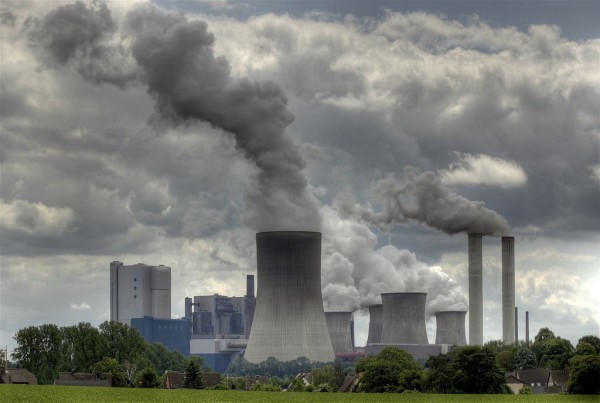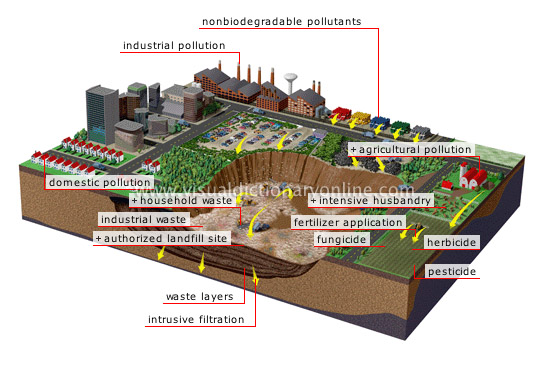![]()
Contaminación por Mercurio de Suelos Urbanos y Periurbanos (Cuencas de Drenaje y Bioacumulación en la cadena trófica)
La contaminación por mercurio envenena la cadena trófica, afectando finalmente la salud humana, especialmente en el caso de las mujeres embarazadas y sus fetos. Su trasporte por el viento, hasta las capas de hielo polares, ya había sido constata con anterioridad. También se conocía que las concentraciones de esta sustancia tóxica llegaba al mar, acumulándose en los tejidos del pescado conforme se bioacumula (biomagnificación)a lo largo de la cadena trófica. De este modo, las autoridades sanitarias han terminado por desaconsejar el consumo de depredadores, como el atún, en los grupos de riesgo anteriormente aludidos. Sin embargo, hasta la fecha, se había investigado muy poco acerca de su presencia en el suelo. El estudio que mostramos hoy nos informa que el mercurio emitido al aire desde las plantas eléctricas alimentadas por carbón, termina depositándose rápidamente en los suelos a lo largo de varios kilómetros, en función de los vientos imperantes en cada zona. De ahí, se desprende rápidamente a las aguas de escorrentía, pasando seguidamente a las cuencas de drenaje, para posteriormente contaminar las aguas marinas. Los estudios fueron realizados en áreas densamente pobladas, es decir en suelos urbanos y periurbanos. Por tanto, se constata de nuevo el daño ambiental y sanitario de las plantas eléctricas que hacen uso del carbón como combustible.

Plantas generadoras de electricidad con combustible de carbón. Fuente: Ecopolitology
El mercurio es una potente neurotoxina, cuyas dañinas repercusiones en la salud de los seres vivos son bien conocidas. Sin embargo, sobre este asunto, ya hablaremos en otro post, por cuanto el problema resulta ser más serio de lo que parece. La razón estriba en que nuestras autoridades no se ponen de acuerdo en como resolver ciertas contradicciones inherentes a sus políticas sanitarias y ambientales. Obviamente, las centrales de carbón son una de las industrias que emiten tal sustancia, aunque no las únicas. Eso sí, estudiar fuentes de emisiones, así como las rutas por la que envenena la cadena trófica y los suelos resulta esencial con vistas a comprender mejor los puntos calientes de contaminación (construcciones, vertederos, etc.) y como son afectados diversos recursos naturales. De acuerdo al análisis que abajo presentamos, a partir de las mencionadas centrales, se contamina el aire que a la postre va a parar al suelo (vía aerosoles) y de ahí, rápidamente, parte de la neurotoxina emigra por los cauces fluviales hacia el mar, en donde es consumida por los peces. Sin embargo la nota de prensa no nos informa de su impacto sobre suelo y los cultivos o pastos que crecen sobre el mismo. Eso sí, que a nadie se le ocurra “moder el polvo” alrededor de estas plantas generadores de energía.

Contaminación de suelos y aguas Fuente: Dr.M.Azizul’s Blog
Finalmente tan solo recordaros que la edafomedicina es un ámbito de la ciencia del suelo que, lamentablemente a penas se imparte en los departamentos de edafología o pedología. Se trata de un problema estratégico que debemos solucionar a la menor brevedad.
Juan José Ibáñez
Soil Samples Reveal Urban Mercury Footprints
ScienceDaily (July 19, 2011) — Indianapolis, St. Louis, Detroit, Buffalo, Richmond and Providence — cities scattered across the eastern half of the United States — have something in common, all have coal-fired power plants. A new study from the School of Science at Indiana University-Purdue University Indianapolis is among the first to investigate mercury deposits in industrialized city soil near this type of facility.
The study, which appears in the July 2011 issue of the journal Water, Air & Soil Pollution, reports that measurable amounts of the mercury emitted by coal-fired power plants is deposited in local soil and subsequently enters regional watersheds, contaminating fish and making them unsafe for human consumption.
Previous research on the spread of environmental mercury has focused on waterways. The IUPUI researchers looked at land, testing soil samples, detecting hot spots of mercury contamination in central Indiana specifically tied to local coal-fired power plants by chemical signatures. Winds blew the mercury contaminated soil to the northeast and the natural flow of waterways brought the mercury back to the southwest, far into bucolic appearing areas frequented by anglers.
While wind patterns vary by cities, the process in various urban areas is similar with mercury emitted from coal-fired power plants contaminating soil that is then transported downstream. Since cities have a high percentage of impervious surfaces like roads and parking lots, the mercury enters waterways rapidly.
«Mercury from coal-fired power plants has been found in the ice at the North and the South Poles, so the fact that these noxious emissions are swept far away to other areas or even continents, with global environmental impact, is well known. What had not been previously shown is the impact of the mercury on the environments in cities, suburbs and rural areas near specific coal-burning power plants,» said senior author Gabriel M. Filippelli, Ph.D., professor of earth sciences at the School of Science at IUPUI.
Coal-fired power plants produce electricity at a relatively low cost. This is false economy, according to Filippelli, who directs the Center for Urban Health at IUPUI, because these cost figures do not factor in the impact of these plants on human health. He is a pioneer in the emerging field of medical geology and served as the first elected chair of the Geological Society of America’s Geology and Health Division.
Mercury poisoning can cause permanent neurological damage in humans. Pregnant women and their fetuses are especially susceptible to mercury, much of which enters the body through consumption of contaminated fish.
«We are fouling our local as well as global environment and little has been done to stop it. It all comes down to the choices we make to produce energy. As we gain a better understanding of the deposition and risk patterns of mercury from using dirty coal as our primary energy source in the Midwest, we hopefully will be better able to stop or decrease the emission of this neurotoxin and halt the damage it is causing humans,» said Filippelli.
Carrie Lynn Hatcher, a former graduate student in the School of Science at IUPUI, now at the University of Toronto, is the co-author of «Mercury Cycling in an Urbanized Watershed: The Influence of Wind Distribution and Regional Subwatershed Geometry in Central Indiana, USA.»
The study was supported by the School of Science at IUPUI and the IUPUI Center for Urban Health.
In a November 2010 publication, the U.S. Geological Survey (USGS) reported that mercury concentrations in Indiana watersheds «routinely exceeded criteria protective of humans and commonly exceeded criteria protective of wildlife.» One in seven fish in Indiana contain mercury in levels not fit for human consumption.
Story Source:
The above story is reprinted (with editorial adaptations by ScienceDaily staff) from materials provided by Indiana University-Purdue University Indianapolis School of Science.
Journal Reference:
Carrie Lynne Hatcher, Gabriel Michael Filippelli. Mercury Cycling in an Urbanized Watershed: The Influence of Wind Distribution and Regional Subwatershed Geometry in Central Indiana, USA. Water, Air, & Soil Pollution, 2010; 219 (1-4): 251 DOI: 10.1007/s11270-010-0703-7
Abtract del Trabajo Original
The global cycle of mercury (Hg) is reasonably well-understood, as are some of the natural and anthropogenic sources of Hg to the atmosphere. Less well understood are the regional and local characteristics of Hg deposition and subsequent watershed-scale transport, important parameters for assessing human risk to various avenues of Hg exposure. This study employed a two-part strategy for understanding coupled deposition and transport processes in central Indiana (USA), including Indianapolis, a typical large city with multiple coal-fired electric utilities and other Hg emission sources. A spatial analysis of Hg concentrations in surface soils revealed elevated Hg proximal to many of the large emission sources, with a distribution aligned along a southwest-northeast axis corresponding to the mean wind direction in this region. This soil distribution suggests some local depositional impact from local utilities, with wind modification affecting the regional pattern. Post-depositional transport of Hg was assessed using a series of streambank sampling arrays as the White River and various tributaries travelled through the urban core of Indianapolis. Streambank sediments had peak Hg concentrations in the urban core, where several local sources are present and where a number of subwatersheds join the main trunk of the White River, suggesting local emission and/or rapid Hg transport from urban subwatersheds due to their relatively high proportion of impervious surfaces. High Hg values persist in White River sediments into rural areas tens of kilometers south of Indianapolis, raising concerns for anglers collecting fish in this apparently pristine environment.

[…] Titular del Centro de Investigaciones sobre Desertificación (CSIC-Universidad de Valencia). http://www.madrimasd.org/blogs/universo/2011/12/13/139918 Imagen de: Dr.M.Azizul’s […]
[…] Contaminación por Mercurio de Suelos Urbanos y Periurbanos (Cuencas de Drenaje y Bioacumulación en… Etiquetas: agricultura periurbana, agricultura urbana, alimentos contaminados, calidad del aire, Huertos urbanos, monitorización, suelos contaminados Degradación de Suelos: Contaminación, Edafología y Política, Fertilidad de Suelos y Nutrición Vegetal, Filosofía, Historia y Sociología de la Edafología, Fraude y Mala Praxis Científica, La Calidad y Las Funciones del Suelo, Los Suelos las Plantas y la Vegetación, Los Suelos y la Salud, Suelos y ambientes urbanos: las Ciudades […]